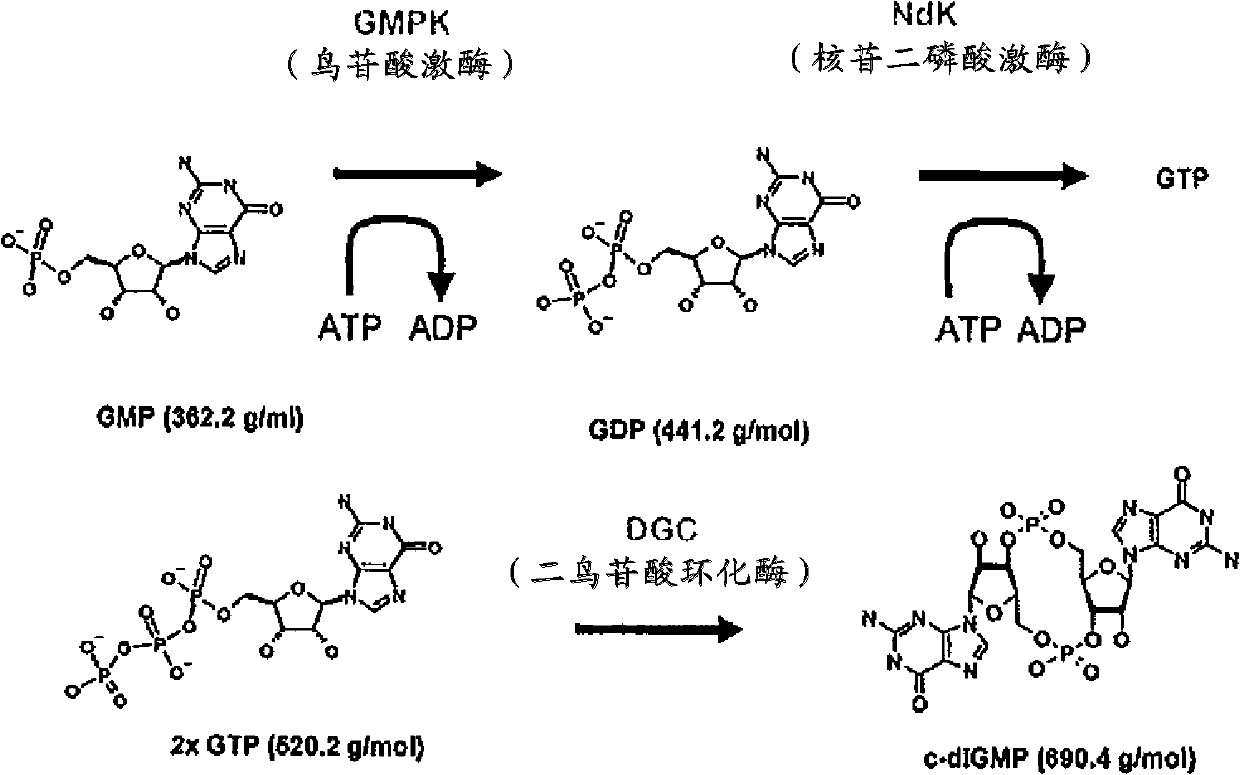Process for the enzymatic production of cyclic diguanosine monophosphate employing a diguanylate cyclase comprising a mutated rxxd motif
A technology of guanylate cyclase and guanosine triphosphate, which is applied in the production of bulk chemicals, biochemical equipment and methods, organic chemistry, etc., and can solve the problems that there is no industrial scale to produce c-di-GMP
- Summary
- Abstract
- Description
- Claims
- Application Information
AI Technical Summary
Problems solved by technology
Method used
Image
Examples
Embodiment 1
[0047] This example describes the cloning, overexpression, purification and characterization of genes for guanylate kinase and nucleoside diphosphate kinase from E. coli.
[0048] a) Gene cloning of Escherichia coli gmpk and Escherichia coli ndk
[0049] Based on the gene database DNA sequences of Escherichia coli GmpK (M84400) and Escherichia coli NdK (X57555), primers for PCR amplification of each gene were designed:
[0050] Ec-gmpK-Forward G GGATCC ATGGCTCAAGGCACGCTTTATATTGTTTCTG
[0051] Ec-gmpK-reverse G AAGCTT CAGTCTGCCAACAATTTGCTG
[0052] Ec-ndk-Forward G GGATCC ATGGCTATTGAACGTACTTTTTTCCATC
[0053] Ec-ndk-reverse G AAGCTT AACGGGTGCGCGGGCACACTTC
[0054] The underlined part is the introduced cloning site. The start and stop codons of the genes are in bold.
[0055]Genomic DNA was isolated from E. coli JM109 by standard methods (Joseph Sambrook and David W. Russell. Molecular Cloning: A Laboratory Manual, Cold Spring Harbor Laboratory Press, Cold Spring Ha...
Embodiment 2
[0063] a) Gene cloning of C. crescentus dgcA
[0064] Based on the gene database DNA sequence of Caulobacter crescentus dgcA (cc_3285; ACCESSION AE005673), primers for PCR amplification of each gene were designed:
[0065] Cacr-002 CAGAAGCGTTGTCGTGCCCATGGTTG
[0066] Cacr-004 TTGCAGGCCAATGTGGTCATGGGCGGCATCGTCGGCCGCATGGG
[0067] Cacr-010 GG TCTAGA ATGAAAATCTCAGGCGCCCGGACC
[0068] Cacr-011 CA GGATCC CGATCAAGCGCTCCTG
[0069] Cacr-014 GG TCTAGACATATG AAAATCTCAGGCGCCCGGA
[0070] The underlined part is the introduced cloning site. The start codon of dgcA is in bold.
[0071] PCR was performed in standard PCR (35 cycles, 30 sec extension time, annealing temperature 55° C.) using 4 ng / ml genomic DNA of C. crescentus CB15 template and 1.0 μΜ primers Cacr-002 / Cacr-004. The expected DNA band representing the 3'-end of the dgcA gene including the R153V-E154M-S155G-D155G mutation was observed after 1% TBE agarose gel electrophoresis. Excise each PCR band, purify the DNA fr...
Embodiment 3
[0077] This example illustrates the production of c-di-GMP from GMP.
[0078] 1250ml freshly refolded DgcA, 5000U NdK (2.8U / μl in 50% glycerol), 5000U GmpK (3.6U / μl in 50% glycerol), guanosine 5'-monophosphate (GMP, 4g, 11mmol), 13.75 g Adenosine 5' disodium triphosphate (ATP) was mixed with 3750 ml of reaction buffer containing 50 mM Tris-HCl, pH 7.5, 10 mM MgCl and incubated at 30 °C for 16 hours with gentle shaking at 80 rpm 2 , 0.5 mM EDTA and 50 mM NaCl.
[0079] purification
[0080] The crude reaction mixture (4800ml) was filtered through cellulose and added to an anion exchange column (Dowex 1 x 2, 400ml Pharmacia XK26, 2.5cm inner diameter, about 70cm long; Cl -Type, washed thoroughly with 0.5% acetic acid, equilibrated with water (2000ml; flow rate 10ml / min) on.
[0081] Water (2000ml, 10ml / min), 2M NH 4 OAc (2000ml, 10ml / min), water (1500ml, 10ml / min), 10mM HCl / 50mM LiCl (1000ml, 10ml / min) washed the column.
[0082] The product was eluted from the anion exchan...
PUM
| Property | Measurement | Unit |
|---|---|---|
| diameter | aaaaa | aaaaa |
Abstract
Description
Claims
Application Information
 Login to View More
Login to View More - R&D
- Intellectual Property
- Life Sciences
- Materials
- Tech Scout
- Unparalleled Data Quality
- Higher Quality Content
- 60% Fewer Hallucinations
Browse by: Latest US Patents, China's latest patents, Technical Efficacy Thesaurus, Application Domain, Technology Topic, Popular Technical Reports.
© 2025 PatSnap. All rights reserved.Legal|Privacy policy|Modern Slavery Act Transparency Statement|Sitemap|About US| Contact US: help@patsnap.com

